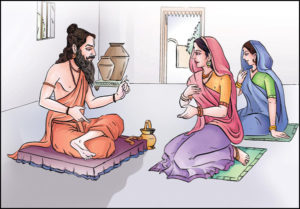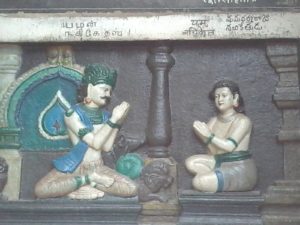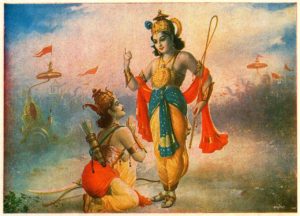To have a Spiritual Conversation is a crux for raising questions related to theology and its teachings. These spiritual conversations are literature which tells more about the core teaching of the spiritual practice and gave an introductory analysis for one person to take the path.
This article features 5 spiritual conversations or Teacher-disciple conversations one must know.
1. King Menander and Venerable Nagasena

King Minander was the Greek ruler of the Greco-Bacteria of the North Western part of the Indian sub-continent which he ruled from his capital Sagala (presently known as Sialkot in Pakistan)
The King was a highly philosophical ruler and would always engage in philosophical debates with his subjects on topics related to science, the existence of God, the meaning of life and what is there after death and many more.
One day while travelling through his city he inquired several questions to his citizens and Venerable Nagasena was in the crowd, gave answers that awestruck him.
The knowledge and the intelligence of the Venerable Nagasena, lead the King in inventing him at his Court and had long conversations in front of several peoples of his kingdom.
The spiritual conversation with King Menander and Nagasena ranged from the cycle of birth-rebirth, the material world and the attainment of Nibbhana (enlightenment). Both of them had a high degree of arguments and discussion on these topics.
The whole conversation has been recorded in the book called Milindapanha which is ancient literature of the Buddhist Theravada Traditions. The literature widely taught in schools in Theravada countries thus gives a very elementary level of understanding of Buddhism.
The book Milindapanha is the easiest book in understanding the fundamental teachings of Buddhism and the logic behind the dharmic teachings. Buddhism is filled with such spiritual conversations.
2. Yajnavalkya and Maitreya

(Picture Credit: kids.baps.org)
The spiritual conversation is between Yajnavalkya a highly respected guru of ancient India, skilled in Vedic philosophy. Whereas, Maitreya is the loyal wife of Rishi Yajnavalkya.
Maitreya is a decent and kind loving woman having a keen understanding of the knowledge spread by her husband.
Once, Yajnavalkya decides to leave the ashram (scholar) life and prepare himself for an ascetic life.
He decided to divide all his property and wealth he earned throughout his life equally between his two wives.
This touched Maitreya and she inquired her husband with a question that, even a normal person would not like to part away from his old possessions but her husband is talking about leading a life renunciation of every wealth and possession of his.
Maitreya asks legitimate questions related to why one should go ascetic life, why it is necessary to leave all the possession of his life and why it is importance.
The conversation then later delves into a very important question as to the love between a husband and a wife in relation. Why a husband is in love with his wife and vice versa. Yajnavalkya explains to Maitreya that a husband does not loves his wife but he loves himself for that the wife is with him, that same also exists in the mind of the wife also.
The love for a wife or husband is not for the other but for oneself. Our love for someone is self-centered and it is never for the other.
The other discussion leads to escaping from this self-centered nature and if one person loves someone then his love is expressed for the whole universe equally.
The spiritual conversation further leads to the topic of the life of renunciation and the life of a Sanyasi (ascetic). Maitreya asks why someone moves away from his worldly adobe to reach the highest goal of self-realization and unification with the Atman.
The spiritual conversation has taken from Brihadranyaka Upanishads from which the mahavakya “Aham Brahma Asmi” is taken.
This is one of the most beautiful spiritual conversations one must read.
3. Yama and Nachiketa

Nachiketa a young boy after seeing this kind of offerings produced by his father in the yagna and demanded a very disturbing question from his father. The young boy asked his father “To whom you will be offering me?”. Young Nachiketa persisted with this question which angered his father and in response, he said “I gave you to Lord of Death!”. Though the act of his father did not harm the innocent nature of Nachiketa and went to the endeavour of his father’s diktat.
He went to the Yama Lok and waited for 3 days outside the doors of the Lord of Death (Yamraj). This act of Nahciketa attracted Yamraj by seeing his persistent nature and granted him three boons that he can ask for.
Young Nachiketa in his first two Boons asked for the welfare of his father and the whole world that they in their lifetime will lead a life for emancipation and the end of suffering. The third boon asked by Nachiketa about the reality of life and what is after death?
The question asked by Nachiketa was first resisted by Yamaraj and instead offer him to ask for any worldly things like a beautiful life, jewels, lands and powers within a state and become a king. Young Nachiketa was determined but did not vary with such offerings by Yamraj, he stuck to the questions he asked.

Then Yamraj after testing his determination had a lengthy spiritual conversation. Yamraj answered all questions related to life and the aim one being in his life has to be thereof. The life after death and how one has to escape from this by looking and concentrating inwards into the Atama.
The Atama is the reality and all the beings through their spiritual enlistment have to liberate by knowing the Atama only. Yamraj further explains the method of training the mind and focus only to Atama through observing the mind and controlling the sense objects where the mind loses its focus. One must not delve into the sense pleasures but rather focus their mind to control their sense spheres. These ancient practices are still practiced and you have these experiences in a guided meditation program.
Thus, the spiritual conversation between young Nachiketa and Yamraj has a highly spiritual reverence.
This spiritual conversation is taken from the Katha Upanishad of Yama-Nachiketa samvad. Upanishads have also given us the Mahavakyas click here to read about them.
4. King Janak and Asthavakra

In ancient India, the kingdom of Mithila ruled a king known as King Janak of Videh. He was a highly knowledgeable ruler of the times and had a passion for spiritual knowledge for that he used to call an assembly of learned men or gurus in his kingdom where learned Brahmins and priests used to come. This assembly was known as Shashtrath of King Janak or the spiritual debate at that time.
Rishi Asthavakra was a highly learned young boy born crippled with bodily deformities. Young Asthavakra participated in one of King Janak’s Shashtrath, where he presented his knowledge of a wise man and answered all questions of the equally learned brahmins and scholars. This influenced King Janak which evolved into a high debated conversation between him and Rishi Asthavakra.
This spiritual conversation has been described in the Brihadaranyaka Upanishad which discusses the spiritual life and how one should leave all worldly possession and develop spiritual faculty. The spiritual conversation also answers why you have to take a spiritual path, what is liberation, what is Atama and how to achieve the Brahmic Gyan (knowledge).
The conversation also discusses how is the life of a Jevan Mukt (person who endured himself with no attachments) and how to become a person having no attachments of this mundane world.
The whole conversation has been presented in the Asthavakra Gita.
5. Arjun and Shri Krishna

This is the most revered spiritual conversation that happened between the two armies of the Kuru clan and the Pandav clan, Arjun the son of King Pandu in mid of battle developed self-doubt.
The doubts shakes him from letting him involve in the war because in front of him he sees those who he loved and revered, for this he cannot fight against them.
Arjun losses his confidence just before the start of the battle and questions what he will achieve through his war if at the end if he survives he will be responsible for the death of his relatives and gurus who he loved and respected. Even if he wins the war no worldly possession can reclaim the loss that he commits through this war. He losses his confidence and drops his weapon in between the war.
Lord Krishna being the charioteer observed the cowardness of Arjun and tells him that he is a Kastriya (a warrior) and he cannot moan in between a war. The act of showing cowardness is against the Kastriya dharma of which he belongs he must take control over him and fight this battle.
Then Shri Krishna tells that he will not kill any being because all beings are Atma and it is the nature of the Atma to take infinite rebirths throughout the celestial cycle of rebirth. Arjun cannot kill a being because the Atama is the only reality which cannot be killed, he will only kill the body of his loved ones who have already been through many lives and will continue this cycle of rebirth.
Continuing his discourse, Arjun asks several questions related to life, rebirth and worldly possession. Lord Krishna explains the path for each being to observe their dharma through different modalities of Yoga. Lord Krishna explains four kinds of Yoga which are Karma Yoga, Gyan Yoga, Bhakti Yoga and other kriyas to achieve human perfection.
This spiritual conversation has been represented in the Bhagwad Gita and is the most important scripture in the Hindu philosophy which is highly canonized in the tradition. The Bhagwad Gita is widely revered and thought of in India and has been an inspiration for a lot of famous personalities.
Conclusion
These spiritual conversations are a part of the age-old teacher-disciple tradition which was practised in India.
This practice involves discussions and questions which are an essential part of the dharma. These conversations can be an inspiration for those who have started their path but don’t know what questions they have to ask. It is also not necessary that the teacher is only a saffron robe-wearing human who knows all the answers.
These conversations have a certain relationship of friendships, husband-wife, teacher and a king’s subject which involves themselves in the spiritual endeavour. This, shows that the teaching is universal and can be thought by anyone possible.






